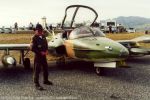
AT-6 artwork

Super Tucano
Posted on 04/19/2011 8:52:54 PM PDT by sukhoi-30mki
U.S. Wants COIN Aircraft For Foreign Training
By Graham Warwick, Bill Sweetman Washington, Washington
For a time it looked as if the wars in Iraq and Afghanistan might spark demand for dedicated counterinsurgency (COIN) aircraft, the way Vietnam gave new life to the A-1 Skyraider and spurred development of the OV-10 Bronco.
A little more than two years ago, the U.S. Air Force envisioned operating a fleet of 100 light-attack/armed reconnaissance aircraft as part of a specialized irregular-warfare wing, and the Navy was evaluating an organic light-attack platform for its special operations forces. Now it looks unlikely that U.S. forces will use COIN aircraft in combat, instead acquiring small fleets with which to train and equip other nations.
History will likely blame the decline in U.S. interest in dedicated light-attack platforms on shifting requirements, inter-service rivalry and pork-barrel politics. But for manufacturers with aircraft to offer, even reduced fleets mean significant business and an inroad to export orders.
When USAF released the original “capability request for information” for the Light Attack Armed Reconnaissance (LAAR) program in July 2009, it drew responses ranging from an armed Air Tractor AT-802U to a modernized OV-10(X) proposed by Boeing. LAAR has since been subsumed into the Light Air Support (LAS) program.
As outlined in the October 2010 request for proposals, the more modest LAS covers the procurement of 20 aircraft for delivery to the Afghan air force beginning in 2013, plus another 15 to meet USAF’s scaled-down LAAR requirement for aircraft with which to “build partner capability”—i.e., train less-capable air forces.
With a ceiling of 55 aircraft and $950 million, LAS is to be an indefinite-delivery/indefinite-quantity contract, suggesting more orders could follow. Declared bidders are Hawker Beechcraft (HBC) of Wichita with the AT-6 and Sierra Nevada Corp., acting as U.S. prime for Brazilian manufacturer Embraer’s offer of Super Tucanos assembled in Jacksonville, Fla.
Bidders must offer turnkey training and logistics support: HBC plans to provide AT-6 training for Afghan instructors and U.S. advisers at Salina, Kan. Sierra Nevada would perform Super Tucano training at Clovis, N.M., adjacent to Cannon AFB, while Embraer plans to supply the training devices.
The LAS competition brings together two aircraft with similar capabilities but different histories. The AT-6 is a development of the T-6 Texan II turboprop trainer produced for the Air Force and Navy. HBC previously delivered armed versions of the T-6, but the AT-6 has an integrated surveillance/attack mission system supplied by Lockheed Martin and derived from its avionics package in the upgraded A-10C attack aircraft.
The Super Tucano, although related to the earlier Tucano turboprop trainer, was a new design developed to meet a Brazilian air force light-attack/advanced-trainer requirement. “The Super Tucano was built for COIN, to operate in an austere environment, with a comfortable cockpit for long flight duration and an open avionics architecture to integrate new systems and weapons,” says Acir Padilha, Embraer’s vice president of military marketing. The Super Tucano carries two .50-cal machine guns in the wing, has five hardpoints under the wing and one under the fuselage for a FLIR turret.
Embraer has delivered 152 Super Tucanos, with a backlog of 28 orders that will continue production through 2012. The Brazilian air force has received 89 of 99 on order, the Super Tucano equipping one training squadron and three operational units charged with protecting resources in the Amazon and policing the borders with Bolivia and Paraguay.
Aircraft have been sold to Chile (12), Colombia (25), the Dominican Republic (eight), Ecuador (18), Indonesia (eight for delivery in 2012) and an undisclosed African customer (nine). Only the Chilean aircraft are solely for training. The Colombian, Dominican and Ecuadorean air forces use theirs for counter-narcotics and close air support missions, with the Colombian aircraft flown primarily at night.
The AT-6’s capability has been developed over a couple of spirals and demonstrated with congressional funding support from the U.S. Air National Guard (ANG). The AT-6 flew with its uprated Pratt & Whitney Canada PT6A-68D engine in April 2010 and the complete mission-system capability, including full-motion video sensor, secure communications, helmet-mounted cueing, missile warning and infrared (IR) countermeasures, was demonstrated late last year. “The system for the ANG demo was more sophisticated than that required for LAS,” says Derek Hess, HBC director for light attack.
In addition to flying close air support, forward air control and other missions for the ANG, the two company-funded AT-6 prototypes have demonstrated the slow-speed intercept role, including flying in a U.S. Northern Command exercise in the Washington area. The AT-6 intercepted slow-flying targets using remote radar data fed to the aircraft.
The Navy, meanwhile, selected the Super Tucano to demonstrate an organic “find/fix/finish” capability for its special forces using a maneuverable, long-endurance, low-heat-signature platform. Imminent Fury was a classified program under which the Navy in 2008 leased a Super Tucano owned by EP Aviation, part of the former Blackwater security company, to develop tactics, techniques and procedures.
The plan was to follow the single-aircraft demonstration at NAS Fallon, Nev., with the deployment of four Super Tucanos leased from Embraer to validate the concept operationally, but Congress refused to fund the program. Lawmakers criticized the Navy and Air Force for not working jointly. Then-Sen. Samuel Brownback (R-Kan.) and then-Rep. Todd Tiarht (R‑Kan.) also worked to block the four-aircraft lease, fearing the 100-aircraft LAAR program would go to Embraer because the AT-6, manufactured in their home state, would not be ready.
Despite a plea for funding from then-commander of U.S. forces in Afghanistan Gen. Stanley McChrystal, Imminent Fury stalled. But Padilha says it “demonstrated field commanders needed the capability urgently,” and paved the way for the LAS program to equip the Afghan air force. USAF, meanwhile, is seeking funding for the first nine LAAR aircraft in fiscal 2012, to be purchased as part of the LAS contract.
A competitive fly-off between the AT-6 and Super Tucano was conducted at Kirtland AFB, N.M., in January, one of each aircraft flying three sorties: one to demonstrate the sensor capability and simulated weapon deployment, one to show operation from an unprepared runway and one in an aerobatic sortie to validate suitability for training. The LAS contract is to be awarded in June or July.
There is a wider resurgence of interest in light attack and armed reconnaissance platforms for several reasons. One is that the ratio of cost to performance for surveillance and targeting systems continues to improve, to the point where they now make sense on a small aircraft.
Another is that many militaries are interested in the “armed overwatch” capability provided by unmanned aircraft like the Predator and Reaper, but cannot acquire them because the Missile Technology Control Regime bans their export in most cases. This has generated demand for sensor- and weapon-equipped versions of relatively low-cost aircraft ranging from Hellfire-armed Cessna Caravans to EADS CN-235 light gunships.
The main beneficiary so far is Alliant Techsystems (ATK), which entered the light attack field in 2008 when its Texas-based aircraft modification unit—the former Mission Research Corp., acquired in 2004—delivered Cessna AC-208B Combat Caravans to USAF for use by the Iraqi air force. The Caravans are equipped with IR/laser-designator turrets and missile-approach warning systems and have a single-rail Hellfire missile launcher under each wing.
ATK’s newest project is a joint venture with Jordan’s King Abdullah II Design and Development Bureau (KADDB) to modify a pair of EADS CN-235 military transports into “light gunships.” The aircraft will be armed with a trainable 30-mm M230 gun (as used on the AH-64 Apache) and equipped with ATK’s STAR mission system—a big-screen operator console combining surveillance, communications and weapon functions—self-defense systems and an L-3 Wescam MX-15D sensor and designator turret. Stub wings above the landing gear sponsons can carry quadruple Hellfire launchers and 70-mm rocket pods—the latter potentially laser-guided—and the aircraft will have local armor.
The main role of the gunships will be border surveillance. Advantages of the platform include persistence, the ability to use small airfields and the fact that the Jordanian air force already uses the CN-235. (The first two aircraft, due to be delivered in 2013, were acquired from the Spanish air force.) ATK hopes there will be more demand for the modification package, and KADDB sees future aircraft being modified in Jordan.
Beyond the CN-235, ATK is also involved with Mohawk Technologies of Florida in a venture to return the Grumman OV-1D Mohawk—a COIN aircraft produced for the Army in the 1960s—to operational use. A demonstrator has been equipped with a FLIR Star Safire turret and a ventral, trainable M230 gun.

AT-6 artwork

Super Tucano
 It would be easier to hit with AAA or portable SAMs.
It would be easier to hit with AAA or portable SAMs.
Blocking the deployment of SuperT's when the military says they need them now. Thanks for putting district politics in front of the needs of warriors.
You would think they could be happy enough selling T-6s to the Iraqis.
OV-1D Mohawk configured for COIN and extended fuel tanks.
 no more Broncos???
no more Broncos??? The OV-10X
The OV-10X

Is the AT-6 a modified Pilatus PC-9?
Thanks, I thought it looked familiar.
The PC-7 and PC-9 are used here as spotter planes during forest fire season.
The AT-6 is artwork indeed, as it is only in the very early stages of being certified to drop weapons. One of the many drawbacks of the AT-6 is it’s lack of an internal gun which necessitates the carriage of two underwing pods. Gun pods are notoriously unreliable and greatly reduce the performance of the already underpowered Texan II (see Fred George’s recent article in Flight International).
Boots on the ground is what produces the numbers that scare the enemy.
It does have a significant advantage, though. In addition to being an American product, it shares commonality with the USAF fleet of T-6AII trainers.
If you take a close look at the airplanes they use the same engine, a Canadian produced Pratt/Whitney. The AT-6 is supposed to upgrade from an 1100shp engine to the same 1600shp used by the ST (they are experiencing some handling problems which caused them to alter the terms of the recent fly-off in NM which, according to USG observers the ST was clear winner). The seats are UK produced Martin Baker's. And while the ST's fuselage is made in Brazil, if you look in the access panels of both you see essentially the same avionics, etc. In fact, the ST is 87.8% "Buy America" compliant.
I flew the ST last year while the Imminent Fury program was ongoing. The cockpit is laid out like any modern 4/4.5 Gen fighter. After take-off, overheads and slow-flight I was using the CCIP system after 20mins into the flight. In my opinion we're wasting time and money waiting for HBC to cobble something together while a superior product is available now...and the taxpayer isn't going to be stuck with development costs.
BTW, HBC is 50% owned by a Canadian firm.
 sweet...
sweet...
 the Dragons with new engines and avionics are no slouch either...
the Dragons with new engines and avionics are no slouch either...
Disclaimer: Opinions posted on Free Republic are those of the individual posters and do not necessarily represent the opinion of Free Republic or its management. All materials posted herein are protected by copyright law and the exemption for fair use of copyrighted works.